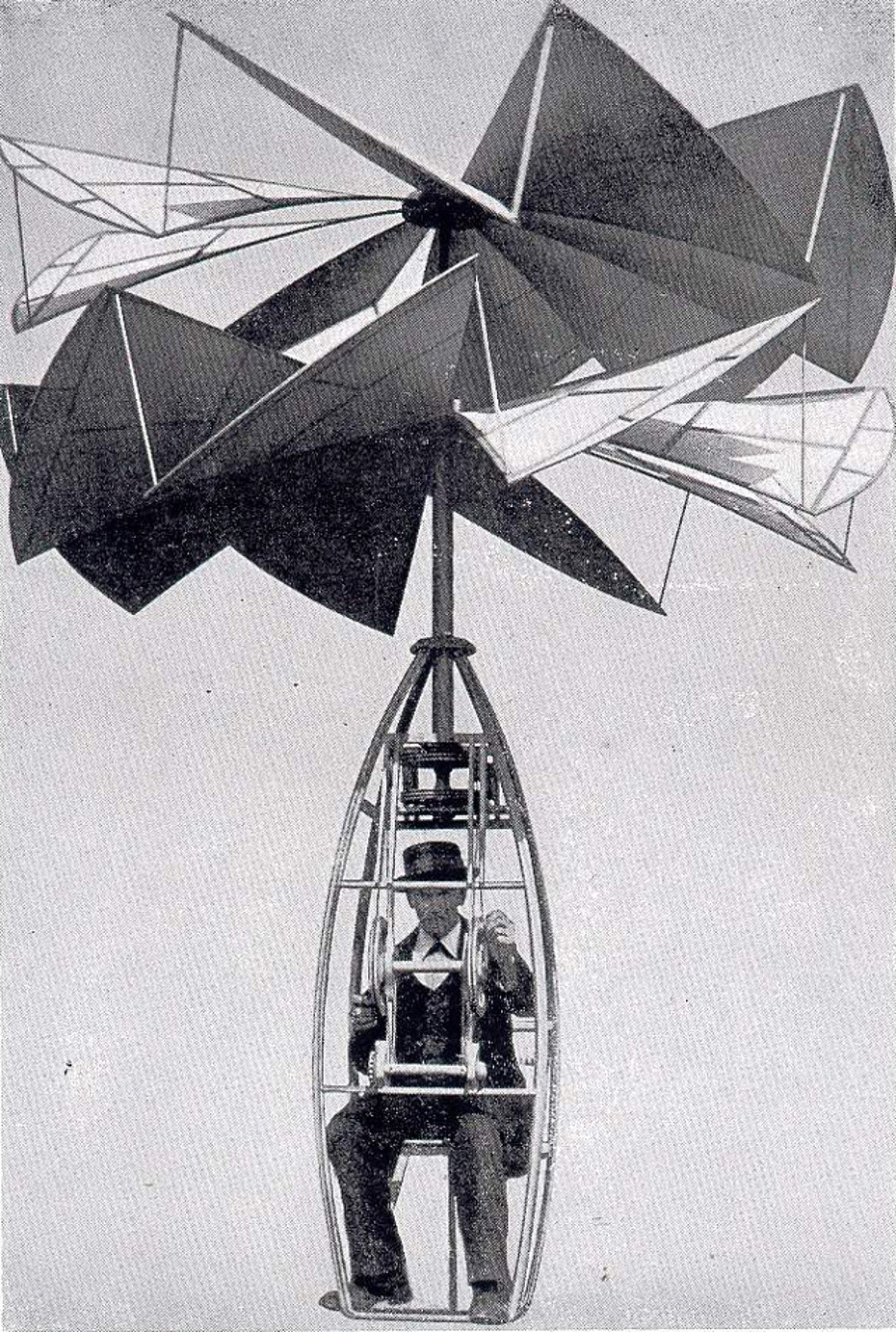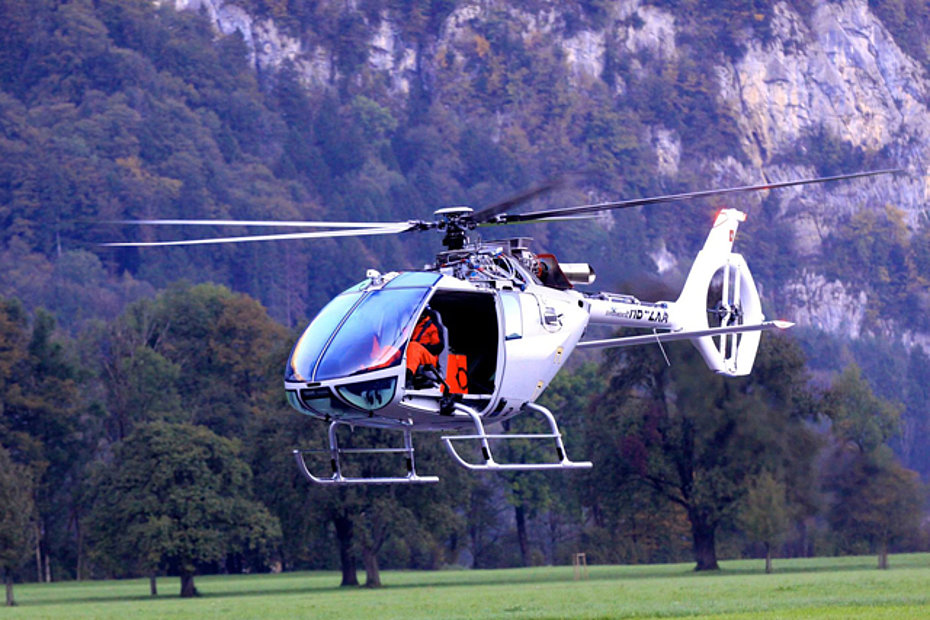
At the beginning of the 20th century the general interest for the aviation and the rotary-wing also "infected" the Swiss. One of the first builders was Hubert Treffner, a farmer from the Canton Appenzell. In 1904-1905 he built a contraption with two coaxial rotors activated by the muscular hand power of the pilot. The latter operated two pulleys with his arms. Treffner's helicopter was officially presented in the city of St. Gallen. Despite the pilot’s obstinacy obviously the contraption didn’t lift off. Almost at the same time in Canton Geneva the brothers Dufaux started the construction of a flying machine. Their first model was a helicopter. Their story is presented in a separate file of this section.
Helicopters "made in Switzerland"? No thanks!
Switzerland probably has the highest helicopter density for km2 in the world. The transport difficulties on its alpine territory encouraged the diffusion of this versatile and now indispensable mean of transport. But what is the Swiss contribution to the development of the rotary-wing? The answer to this question is simple. The contribution of Switzerland is quite limited.
Unlike the neighboring nations, as for example, Italy, France or Germany, in our Country up to today no helicopter was been developed and manufactured in series. The situation is different when it comes to airplanes, because different models have been produced in series, some of which are very famous like those manufactured by Pilatus Aircraft in Stans.
But let’s go back to the rotary-wing to give space to an interesting statement which still needs to be officially confirmed. During research this is synthetically what some people told me.
By the end of the '40s Leone Concato, a high-profile man of the Italian aeronautical post war period, brought the first helicopters of the Bell 47 series in Italy. In May 1949 he founded Aersilta, the first Italian helicopter company. He purchased the Bell 47D-1 I-SILT in the United States and obtained the Italian sale agency from Bell.
With the outbreak of the Corean war in 1950, almost all of Bell’s production was for the US Army. For this reason Aersilta was put into great financial difficulties. It was in fact very difficult to obtain the necessary spare parts and it was also difficult to place new orders for the civil market. Therefore Concato asked Larry Bell the authorization to produce the Bell 47 in series. The latter reflected upon the proposal and then gave his approval. The Italian entrepreneur did not waste any time and immediately began the research to find someone interested in the production of the helicopter.
Apparently among the group of companies which were not interested in Concato's plans, there was the Pilatus Flugzeugwerke AG in Stans! At that time the Swiss company was manufacturing the two seater training airplane P-2, and was developing new models such as the P-3. Hence they probably had no interest (or no resources) to invest elsewhere.
By the beginning of 1952 the Italian company Agusta of Cascina Costa finally shows its interest for this new business. Initially Agusta manufactured in sub-license of Aersilta the Bell 47. Much later the latter company was dissolved and Concato was employed by Agusta and then became its vice-president.
Probably we will never know the truth about these facts. However if this story should be one day confirmed, Switzerland probably wasted one of its greatest opportunities to become one of the world's leader of the rotary-wing field! Obviously this is only a theory. The reasons why some firms were not interested in the production of helicopters is quite evident. At that time the potentials of the helicopter were probably unknown to a large part of the possible customers. Agusta accepted Concato's proposal and taking a big risk decided to invest in the new invention. The rest as we now know is simply history.

Kopter/Leonardo SH-09
In 2002, Martin Stucki aviationengineer and commercial helicopter pilot began designing a helicopter called the SKYe SH-09 that incorporated some innovations such as the structure built entirely of composite materials and a cabin that offers great visibility. In 2007 Stucki created the company Marenco (Martin Engineering and Consulting) in order to continue the development of his project. At the beginning the team working on the project was made up of a restricted group of engineers. Then it expanded and to include various engineers from other helicopter factories such as Airbus Helicopter. In 2016 the company had over 100 employees. In Switzerland, the activities were divided between Pfäffikon/ZH where there are the design offices and Mollis/GL where the test flights are carried out. There is a third location in Germany which manages the procedures required to obtain the certification. The first prototype of the pre-series known as the SKYe SH-09 (call sign HB-ZXA) made the first test flight on October 2, 2014 in the hands of the test pilot Dwayne Williams. At that time the company was counting on obtaining the certification within 12-16 months, a goal that, to date, has not yet been reached.
Two more pre-series examples were produced over the next four years. In January 2018 the company changed its name to Kopter SH-09.
On 8 April 2020 Kopter was purchased by Italian giant Leonardo for $185 million. On 21 April 2021, the helicopter received its new commercial name AW09. Kopter and Leonardo plan to start series production by the end of 2022. The number of orders is not officially known, but current rumours speak of around 70 aircraft.
The SH-09 will really be the first civilian helicopter developed and manufactured in Switzerland? We'll see...
HAB 10/2021

